In the Moment:
Michael Frye's Landscape Photography Blog
by Michael Frye | Mar 14, 2013 | Light and Weather, Vision and Creativity
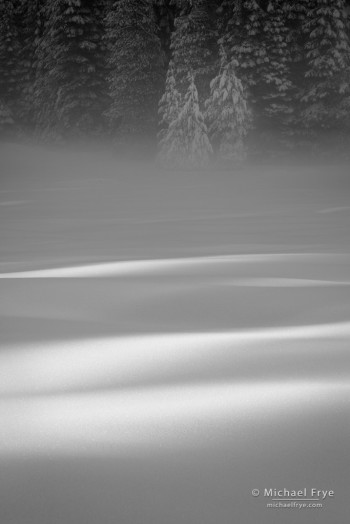
Sunlight slanting across Crane Flat Meadow, Yosemite NP, CA, USA
A Trip to Crane Flat
Yosemite got some much-needed precipitation last week – over an inch total. I kept checking the radar and satellite images online, looking for an opportunity to photograph a clearing storm. Friday morning seemed promising, so I drove up to Yosemite Valley early, but found no snow. It looked like the snow level had been around 5,000 feet, higher than forecast. Worse, from a photographic perspective, the skies were clear and there was no mist.
Shortly after sunrise I noticed light striking a ridge near the tunnels on Highway 120, and on a whim decided to drive up to Crane Flat. I thought Crane Flat would at least have some fresh snow, since it’s at 6,000 feet.
Indeed there was fresh snow – over a foot of it. I parked at the Tuolumne Grove trailhead and walked along the plowed road. The sun had just reached parts of the main meadow, and I found some interesting small subjects to photograph, like tree-shadows on the snow.
Some shafts of sunlight slanting across the snow caught my attention, and then some mist began rising near the edge of the meadow, behind the shafts of light. I immediately recognized the potential to make an image that went beyond an abstract study of shadows – a photograph that had a mood.
(more…)
by Michael Frye | Mar 7, 2013 | Announcements
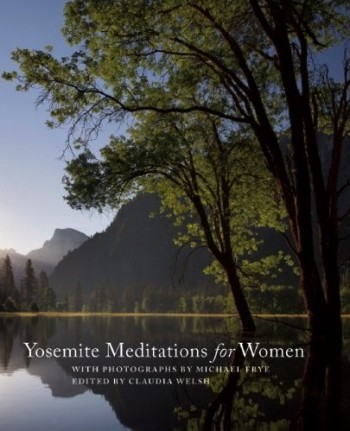 It’s finally here! My wife Claudia did a wonderful job of editing Yosemite Meditations for Women, finding inspiring quotes from writers like Lorraine Anderson, Susan Zwinger, J.K. Rowling, Diane Ackerman, Pam Houston and many others, and pairing the quotes with my photographs. I’ve included some sample pages below.
It’s finally here! My wife Claudia did a wonderful job of editing Yosemite Meditations for Women, finding inspiring quotes from writers like Lorraine Anderson, Susan Zwinger, J.K. Rowling, Diane Ackerman, Pam Houston and many others, and pairing the quotes with my photographs. I’ve included some sample pages below.
If you order directly from us through the “Add to Cart” button below, Claudia and I will both sign the book(s). Or you can order directly from the publisher, the non-profit Yosemite Conservancy, or from Amazon.
We hope you like the book, and really appreciate your support!
— Michael Frye
Yosemite Meditations for Women
Hardcover with jacket; approx. 6×5 inches; 96 pages
9.95

(more…)
by Michael Frye | Mar 5, 2013 | Yosemite Photo Conditions
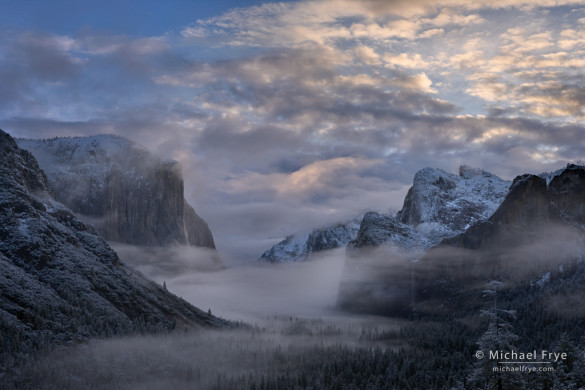
Winter sunrise from Tunnel View. With the right conditions Tunnel View can be great in the morning as well as the afternoon
January and February are the wettest months of the year in Yosemite. The average precipitation for January is 6.5 inches, while for February it’s 6.7 inches, which makes 13.2 inches for the two months combined.
But this year Yosemite received only a tenth of that: 1.33 inches total for January and February. The Sacramento Bee says it’s the driest January and February on record for the northern Sierra Nevada.
Since storms have been so rare lately, any forecast that calls for precipitation is big news, and we’ve got just such a forecast this week. Meteorologists are predicting a medium-sized storm to reach Yosemite tonight and tomorrow, with lingering showers on Thursday and Friday. The timing is hard to predict from the current forecast, but it’s likely that we’ll see clearing storm conditions either late Wednesday, Thursday or Friday. With the showery weather there may be several clearing-storm events during that time.
(more…)
by Michael Frye | Feb 22, 2013 | Yosemite Photo Conditions
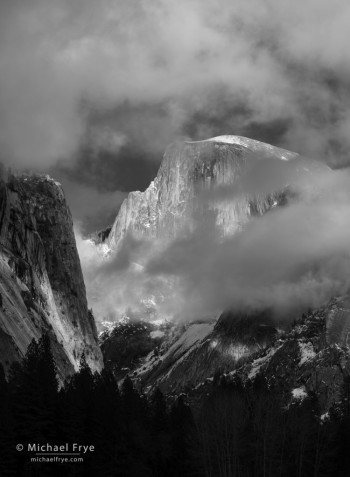
Half Dome and clouds, Yosemite NP, CA, USA
Many people, including me, had high hopes for the snowstorm that came through Yosemite on Tuesday. The forecast called for six to twelve inches of snow, so it sounded like we would see some beautiful snow scenes, and maybe even get to photograph a clearing storm. And some moisture might help revive Horsetail Fall.
Around sunset on Tuesday it started snowing at my house in Mariposa — first lightly, then heavily. In no time we had three or four inches of snow, and eventually got six inches, which is a lot for our 2700-foot elevation.
But the storm looked very compact on radar, and the precipitation didn’t seem to be reaching Yosemite. I called my friend Kirk Keeler, who lives in Yosemite Valley, and he told me that they had received only half an inch of snow.
Wednesday morning Claudia and I cleared the snow off our car and drove up to Yosemite Valley. We found an inch or two of snow — not a lot, but enough to highlight every tree branch. I saw many beautiful scenes with trees etched in snow, including the pattern of cottonwood branches below.
The morning was clear, but later some evaporation clouds started to appear, and they kept building. By the end of the day all the cliffs were hidden by clouds. But between 4:00 to 4:30 in the afternoon Half Dome and the clouds put on a great show. Half Dome would vanish completely, then reappear, wrapped in clouds and speckled with sunlight. I made the photograph above just before Half Dome disappeared for good.
(more…)
by Michael Frye | Feb 16, 2013 | Yosemite Photo Conditions
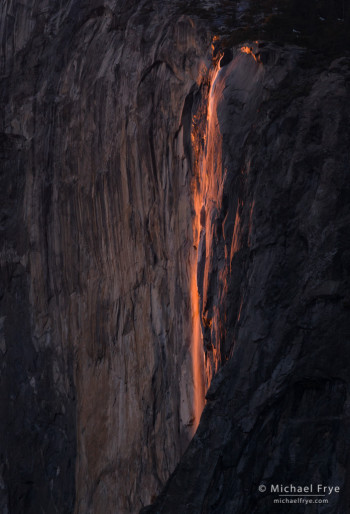
Horsetail Fall at 5:34 p.m. yesterday
It’s been quite dry in Yosemite since December, but there’s still some snow on top of El Capitan, and I thought that the warming weather over the last few days would melt some of that snow and increase the water flow in Horsetail Fall. But the flow is still disappointingly meager. I had a chance to photograph Horsetail last night, and I would say the water level is about the same as last year. The accompanying photograph was made from the Southside Drive area at about 5:30 p.m. yesterday. What water there is gets nicely highlighted when the light is just right, especially near the bottom of the fall, but… I wish the flow was better.
With low water like this I think the Southside Drive spot (Location 10 in my Photographer’s Guide to Yosemite book and iPhone app) works a little better than Rowell’s View near the El Capitan picnic area along Northside Drive (Location 1). From Southside Drive you’re a little further away, and you can see a bit more of the bottom of Horsetail Fall, which is the part that shows up best with conditions like this.
It’s supposed to be warm again today, so that might help increase the flow, but then temperatures are expected to trend downward tomorrow and Monday. On Tuesday forecasters are predicting the arrival of a snowstorm, which is expected to leave even colder air in its wake. The bad news is that the colder temperatures will slow down the flow in Horsetail Fall. The good news is that… a snowstorm is coming! And that, of course, brings the possibility of photographing snowy trees and cliffs, and maybe a clearing storm.
(more…)
by Michael Frye | Feb 13, 2013 | Yosemite Photo Conditions
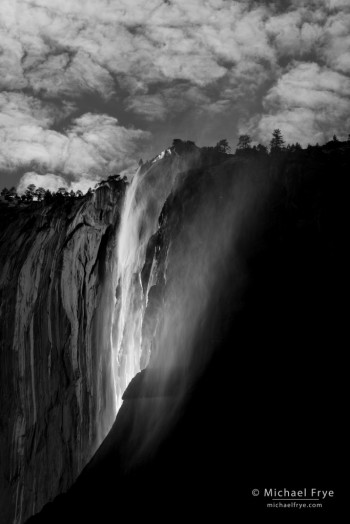
Horsetail Fall and clouds on a March afternoon, Yosemite NP, CA, USA
I’m happy to be up and running after dealing with some computer issues, and can give you a quick report on Horsetail Fall. During a private workshop on Monday I had a chance to check out the water flow. I’d say it’s a little below average for mid-February, but definitely better than last year. Despite six weeks of mostly dry weather there’s still some snow on top of El Capitan to feed the waterfall, and temperatures are supposed to rise a bit this week, which should help melt that snow and increase the water volume.
The window of best light for Horsetail Fall starts this weekend and lasts about a week to ten days. If our dry spell continues we should see some clear skies at sunset during that time — an essential requirement for the Horsetail light show. But the long-range forecast calls for precipitation next Tuesday and Wednesday, so we’ll see.
As a reminder, I’ll be at the reception for my exhibit at The Ansel Adams Gallery this Saturday from noon to 2:00 p.m., and also at the Yosemite Renaissance opening reception the following Friday, February 22nd, from 5:30 to 7:30 p.m. at the Yosemite Museum. I hope to see you at one of those events if you’re in the area!
— Michael Frye
Related Posts: Horsetail Fall Questions; The Best Time to Photograph Horsetail Fall, Revised
Michael Frye is a professional photographer specializing in landscapes and nature. He is the author and photographer of The Photographer’s Guide to Yosemite, Yosemite Meditations, and Digital Landscape Photography: In the Footsteps of Ansel Adams and the Great Masters, plus the eBooks Light & Land: Landscapes in the Digital Darkroom, and Exposure for Outdoor Photography. He has written numerous magazine articles on the art and technique of photography, and his images have been published in over thirty countries around the world. Michael has lived either in or near Yosemite National Park since 1983, currently residing just outside the park in Mariposa, California.
by Michael Frye | Jan 31, 2013 | Yosemite Photo Conditions
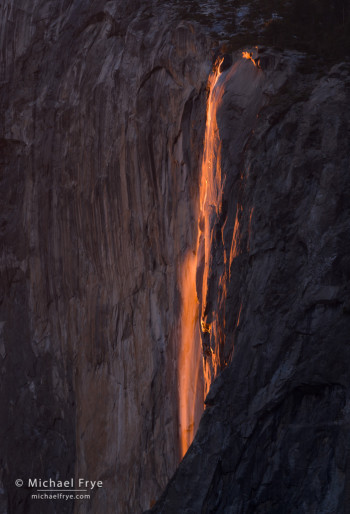
Low water, but ideal light on Horsetail Fall, February 20th, 2012
It’s almost February, so naturally I’ve been getting a lot of questions about Horsetail Fall. My thoughts about the best time to photograph Horsetail haven’t changed since I wrote this post last year: basically it’s February 16th to 23rd, or maybe a little beyond that.
This window was confirmed by my observations in 2012. There wasn’t much water in the fall last year, but we had a string of clear days, which allowed me to closely watch the light, and I think that February 16th to 23rd window is about right. You can, of course, take good photographs before or after that window; I’m talking about ideal light.
That ideal light requires clear skies to the west at sunset, something no one can predict at this point. And for good photographs the waterfall has to be flowing. Overall we’ve had a lot more rain and snow than last year, and Horsetail is flowing now. January, however, has been pretty dry, and there’s no precipitation in the forecast until at least next Wednesday. I think Horsetail will have more water this year than last, regardless of what happens over the next couple of weeks, but it would be nice to get some more snow on top of El Capitan soon to help feed Horsetail.
(more…)
by Michael Frye | Jan 23, 2013 | Composition, Vision and Creativity
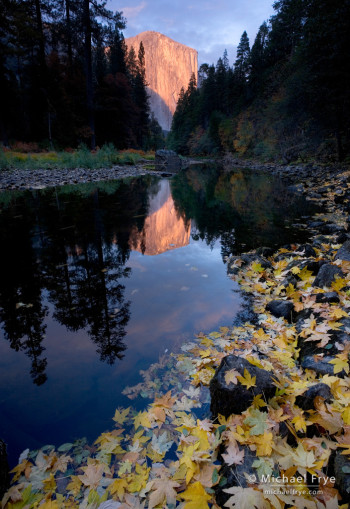
El Capitan and the Merced River, autumn, Yosemite NP, CA, USA
Depth can be a powerful tool in photography. Our medium is two-dimensional, but a sense of depth, an illusion of space and distance, can make the viewer feel like part of the scene, and literally and figuratively add another dimension to a photograph.
A Common Formula
This image of El Capitan follows a common formula for creating a three-dimensional effect in landscape photographs: find an interesting foreground (preferably with some leading lines), get the camera low and close to that foreground, and use a wide-angle lens.
A wide-angle lens by itself can’t create a sense of depth. Wide-angle lenses make things look smaller, and therefore more distant, but if everything looks small and distant there’s no sense of depth. The 3-D effect only happens when you put the wide-angle lens close to something in the foreground. That proximity makes the foreground look big, but things in the background still look small. The optics create an exaggerated size difference between near and far objects, and our brains interpret that as depth and distance.
This wide-angle, near-far look is common today, but it wasn’t always so. Though he wasn’t the first to use this perspective, master landscape photographer David Muench popularized this technique through his many beautiful books, and a lot of people have followed his lead.
But this look has become so popular that I think landscape photographers have stopped looking for other ways to create a sense of depth, and by doing that we’ve limited our options. We owe it to ourselves and our viewers to explore other paths, and create images with depth and meaning that go beyond this one formula.
(more…)
by Michael Frye | Jan 14, 2013 | Announcements, Workshops
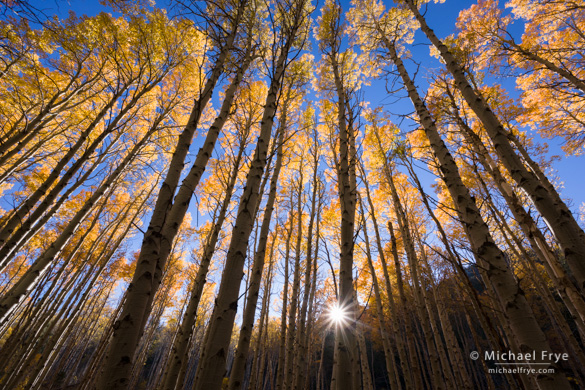
Aspen grove, late afternoon, Lee Vining Canyon, Inyo NF, CA, USA
If you’re not subscribed to my email list you missed the announcement of my Eastern Sierra Fall Color: Composition and Creativity Among the Aspens workshop next fall. We had such a great response to this offering that it sold out the first day! But the good news is that we decided to run a second edition of this course from October 20-23, 2013, and there are still a few spots available.
I made the accompanying photograph during the first edition of this workshop last October. We photographed this aspen grove late in the afternoon as the lowering sun backlit the yellow leaves. This was my favorite image from that spot, but I saw many interesting, unusual compositions by everyone else that afternoon, both on the back of people’s cameras and later during image reviews. You can see some of the participant’s photographs in this Flickr group.
(more…)
by Michael Frye | Jan 13, 2013 | Announcements

Yosemite Meditations for Women
My wife Claudia and I just got an advance copy of our new book, Yosemite Meditations for Women, published by Yosemite Conservancy. Claudia did a wonderful job of editing this — finding quotes, pairing them with photographs, and getting permissions from the authors. I’ll let you know when it’s available — it should be sometime next month!
— Michael Frye



















